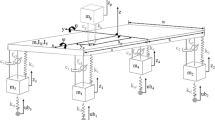Abstract
In order to solve the problem of MR-SAS and electric power steering (EPS) integrated control, the suspension and steering system integrated dynamic model was established, and the variable universe fuzzy PID integrated controller was designed. Due to the difficulty of self-adaptive and the superiority of compound control of fuzzy control, the variable universe fuzzy PID compound controller based on fuzzy inference was designed. The fuzzy on–off control based on trapezoidal membership function was used to the fuzzy control and PID control. And the random road input and steering wheel angle step input simulation experiment was carried out in the integrated system. Compared with the passive system and separate control, experimental results show that the integrated control system has obvious superiority.













Similar content being viewed by others
References
Zheng L, Li Y, Wei J et al (2009) Coordinated control of semi-active suspension with magnetorheological dampers and electrical power assist steer system. J Vib Eng 5:012
Wang Q, Qin W, Chen W (2010) Modeling and control of vehicle electric power steering and active suspension system based on multibody dynamics and rule-based coordination. Zhongguo Jixie Gongcheng (China Mech Eng) 21(14):1709–1714
Wang H, Chen W, Yang L et al (2012) Coordinated control of vehicle chassis system based on game theory and function distribution. Jixie Gongcheng Xuebao (Chin J Mech Eng) 48(22):105–112
Chen W, Wang Y, Wang Q et al (2005) Study on multi-variable adaptive integrated control of automobile electric power steering and active suspension systems. J Vib Eng 3:019
Chen W, Zhu H (2011) Coordinated control of vehicle ride comfort and handling stability based on state identification. Jixie Gongcheng Xuebao (Chin J Mech Eng) 47(6):121–129
Prabakar RS, Sujatha C, Narayanan S (2013) Response of a quarter car model with optimal magnetorheological damper parameters. J Sound Vib 332(9):2191–2206
Metered H, Bonello P, Oyadiji SO (2010) The experimental identification of magnetorheological dampers and evaluation of their controllers. Mech Syst Signal Process 24(4):976–994
Kong L, Zhao X, Qi B. (2011) Study on semi-active suspension system of tracked vehicle based on variable universe fuzzy control. In: 2011 IEEE international conference on mechatronics and automation. IEEE, pp 2276–2280
Duan M, Li G, Shi J et al (2012) Research on the adaptive fuzzy control based on variable universe of with magneto-rheological suspension. Adv Mater Res 433:7112–7118
Zadeh LA (1965) Fuzzy sets. Inf Control 8(3):338–353
Özceylan E, Kabak M, Dağdeviren M (2016) A fuzzy-based decision making procedure for machine selection problem. J Intell Fuzzy Syst 30(3):1841–1856
Bustince H, Barrenechea E, Pagola M et al (2016) A historical account of types of fuzzy sets and their relationships. IEEE Trans Fuzzy Syst 24(1):179–194
Gao J, Xu L, Huang F (2016) A spectral–textural kernel-based classification method of remotely sensed images. Neural Comput Appl 27(2):431–446
Lad RK, Dange PS (2016) Fuzzy sludge quality index on the basis of fertilizer potential after primary clarifier. Procedia Technol 24:116–123
Gao J, Fan LY, Li L et al (2013) A practical application of kernel-based fuzzy discriminant analysis. Int J Appl Math Comput Sci 23(4):887–903
Zimmermann HJ (1996) Fuzzy control/fuzzy set theory—and its applications. Springer, Netherlands, pp 203–240
Carvajal J, Chen G, Ogmen H (2000) Fuzzy PID controller: design, performance evaluation, and stability analysis. Inf Sci 123(3):249–270
Fei L, Yi-nong L, Ling Z (2013) Variable universe fuzzy control for the magneto-rheological semi-active suspension in armored vehicles. Automot Eng 35(8):735–739
Author information
Authors and Affiliations
Corresponding author
Ethics declarations
Conflict of interest
The authors declare that there are no competing interests regarding the publication of this paper.
Rights and permissions
About this article
Cite this article
Cao, Z., Zheng, S. MR-SAS and electric power steering variable universe fuzzy PID integrated control. Neural Comput & Applic 31, 1249–1258 (2019). https://doi.org/10.1007/s00521-017-3157-7
Received:
Accepted:
Published:
Issue Date:
DOI: https://doi.org/10.1007/s00521-017-3157-7




